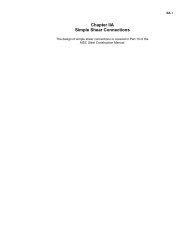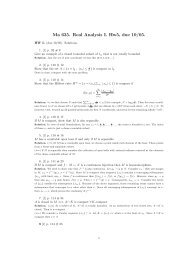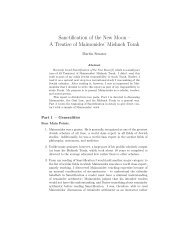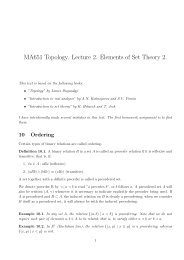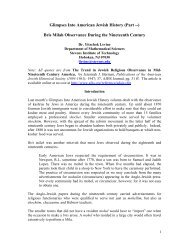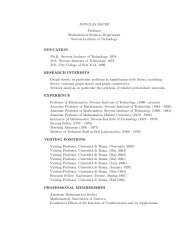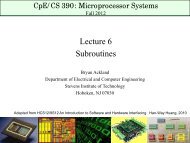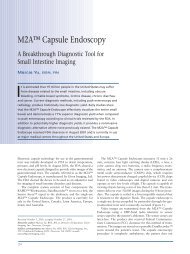You also want an ePaper? Increase the reach of your titles
YUMPU automatically turns print PDFs into web optimized ePapers that Google loves.
<strong>American</strong> <strong>Jewish</strong> History <strong>101</strong><br />
Things Most People Never Learn in School<br />
Faculty Forum 10/17/07<br />
Names: Aaron Lopez, Dr. Samuel Nunez, David Machado,<br />
Rebecca Mercado Phillips, Louis Moses Gomez, David Gomez,<br />
Benjamin Gomez, Isaac Leeser, Abraham I. Abrahams, Raskas,<br />
Gratz, Jacob Mordecai, Asser Levy, Jacob Barsimson, Rabbi<br />
Abraham Rice, Rabbi Dr. Bernard Drachman, Harry Fischel,<br />
Gershom Kursheedt, etc.<br />
Places: Recife, Curacao, Suriname, Nevis, Savannah,<br />
Philadelphia, Richmond, New Orleans, Warrenton, NC, Jamaica,<br />
Newport, St. Louis, etc.<br />
Only thing that I know learned in yeshiva about <strong>American</strong> <strong>Jewish</strong><br />
<strong>history</strong> is that Chayim Salomon financed the Revolution. Sorry,<br />
may not be true.<br />
I. Appreciate the opportunity to again speak at a Faculty Forum<br />
How was the lecture? Ask the students, not me. Invited<br />
back indication that I am doing something right or you people<br />
are masochists.<br />
II. Became interested in early <strong>American</strong> <strong>Jewish</strong> <strong>history</strong> – focus<br />
observance<br />
A. Most of literature – Jews who did this or that, not about<br />
their adherence to Yiddishkeit<br />
B. JHS exhibit – Aaron Lopez, Rebecca Gratz: no mention<br />
that both were Shomer Shabbos<br />
Israel Baer Kursheedt (1766 – 1852)<br />
Sources: Asmonean and The Occident (Isaac Leeser) 1852<br />
1
I. Early <strong>American</strong> Jewry – no ordained rabbis stayed here from<br />
1654 until 1840<br />
A. Rabbi Abraham Rice – 1840 Found Chaos<br />
B. Chazzanim, better educated Ba’alei Batim, mohellim:<br />
businessmen<br />
C. Recife, Brazil 1630 – 1654. 1642 imported religious<br />
officials from Amsterdam<br />
D. So bad that many European communities would not<br />
accept a Get or gayrus from America<br />
II. One Talmud Chocham here who came before 1800 – IBK<br />
III. Youth - Born in Sing-hafen, Germany near the Rhine on the<br />
4th day of Pesach in 5526. (April 6, 1766)<br />
A. Orphaned at young age, mother relocated to Kursheidt<br />
(near Konigswinter)<br />
B. Showed brilliance – sent to yeshiva of Rav Nosson Adler<br />
(1741 – 1800) in Frankfurt<br />
C. Most famous student R. Moshe Schreiber (Chasam<br />
Sofer, 1762 - 1839)<br />
D. Good student<br />
Among IBK’s fellow students were two who particularly<br />
distinguished themselves and attained considerable eminence -<br />
Rav Avraham Bing (1742 – 1841) and Rav Wolf Heidenheim (1757<br />
– 1832). Rav Bing became the Chief Rabbi of Wurzburg. His<br />
students included Rav Jacob Ettlinger, Rav Nathan Marcus<br />
Adler, Chacham Isaac Bernays, and Rav Seligman Baer<br />
Bamberger. Rav Heidenheim is known for his many literary<br />
publications, including a Hebrew commentary on, and a German<br />
translation of, the Machzor. Rodelheim Machzor.<br />
2
According to the above cited articles from the Asmonean and<br />
the Occident, Rav Nosson Adler held these three students in<br />
equal estimation. Rav Adler used to say that Reb Avraham was a<br />
charif (acute logician), Reb Wolf a medackdek (grammarian and<br />
philologist), and Reb Yisroel a chochem, a wise man whose<br />
accomplishments in Torah learning were universal.<br />
IV. Studies interrupted in 1792 by French Revolution<br />
A. General Adam Custine invaded Frankfurt<br />
B. Asked Jew where to camp – beautiful park, off-limits to<br />
Jews<br />
C. Contract to supply Prussian army – how sheltered<br />
yeshiva boy was able to do this. Danger, dealing with gentile<br />
military men<br />
D. Peace in 1795 – decided to leave Germany – Conditions<br />
for Jews not good. Special taxes, bridge tax<br />
V. Hamburg – London, ship to Boston<br />
A. Heard there was a <strong>Jewish</strong> community there<br />
B. Booked passage on Simonhoff, 70 to 80 ton vessel<br />
C. Passage took 70 days!<br />
D. Spoke no English – captain, Rosh Hashanah, Yom<br />
Kippur, Bible<br />
E. Arrived in Boston at end of 1796 – only one <strong>Jewish</strong><br />
family, left for NY after short time<br />
VI. Small number of Jews in America – <strong>Jewish</strong> population of NY<br />
According the “The Rise of the <strong>Jewish</strong> Community of NY” by<br />
Hyman B. Grinstein<br />
3
VII. NY 1796<br />
“Israel Baer's first impressions of <strong>Jewish</strong> life in New York must<br />
have left him crestfallen. In material terms, the <strong>Jewish</strong><br />
community consisted of a synagogue building on Mill Street<br />
dating back to 1730, an adjoining hebra [meeting place and<br />
schoolhouse], the minister's house, and a cemetery on Chatham<br />
Square. Its upkeep was the cause of frequent outbreaks<br />
[disagreements] among the trustees of Shearith Israel; until<br />
1825, it would be the only <strong>Jewish</strong> cemetery in New York City.<br />
They [the Jews of New York] knew little of <strong>Jewish</strong> traditions.<br />
Neglect, apathy, and petty bickering were pervasive.” (The<br />
Seixas – Kursheedts, pages 29 -30)<br />
VIII. Gershom Mendes Seixas (1745-1816) Appointed Chazzan of<br />
SI at age 23 –<br />
4
A. Not rabbi – served almost 50 years – patriotic Chazzan,<br />
left NY for Philadelphia during Revolutionary War.<br />
B. Quickly made acquaintance of IBK – appreciated value<br />
of IBK’s learning<br />
C. On January 18, 1804, he married Sarah Abigail (Sally)<br />
Seixas (1778 – 1854), the eldest daughter of Chazzan Seixas.<br />
Sarah was the favorite child of Rev. Seixas and IBK became his<br />
favorite son-in-law.<br />
D. In New York IBK went into business. “He had his share<br />
both of prosperity and of adversity, like all other men. But the<br />
one never rendered him arrogant, the other could not cast him<br />
down. There were in his character two remarkable traits that still<br />
kept him upright and enabled him to preserve the serenity of his<br />
mind: trust in God and good opinion of men. He was incapable<br />
of believing in the bad intentions of others. And though he, more<br />
than once or twice, suffered severely from his confidence being<br />
abused, he could not be persuaded that the cause was other<br />
than imprudence or folly on the part of those through whom he<br />
suffered. His trust in God was firm and not to be shaken, as it<br />
sprung from his profound conviction of the truth of his religion<br />
and consequently in the wisdom and goodness of Providence.”<br />
(The Asmonean)<br />
IX. Communal Activities<br />
A. As a man with a growing family, it was only natural for<br />
IBK to become involved in the <strong>Jewish</strong> education offered by<br />
Yeshibat Minhat Arab, which Shearith Israel had established in<br />
1731. He believed strongly that <strong>Jewish</strong> education was “the first<br />
thing that ought to be pursued in life.” With this goal he worked<br />
diligently to expand the curriculum of this yeshiva.<br />
B. In 1808 IBK was appointed to a committee of six to draft<br />
a detailed proposal and regulations for the reorganization of the<br />
yeshiva into a real <strong>Jewish</strong> day school for boys and girls. The<br />
school remained active until 1822. Its aims, as articulated by<br />
Israel Baer, were: 1) to instruct students in religion and morality,<br />
5
2) to make sure their actions are in harmony with these<br />
teachings, and 3) to “impress on their minds the excellence of<br />
our belief.” In 1810, in recognition of his service to the <strong>Jewish</strong><br />
community, IBK was elected parnas (president) of Shearith<br />
Israel and served for one term.<br />
C. Israel Baer fought many battles at Shearith Israel; not all<br />
were victorious, especially in matters involving ingrained<br />
customs. In 1809 he and other forward-minded congregants<br />
attempted to restrict Mi she-Berakh prayers, made on behalf of<br />
individuals called to the Torah (for which it was customary to<br />
make a donation to the synagogue) to three per person. The plan<br />
was not adopted.<br />
X. Richmond, VA – 1812-1824<br />
A. Chazzan<br />
B. Isaac Leeser, forefront of everything <strong>Jewish</strong> in 19 th<br />
Century<br />
C. Jacob Mordecai – Female academy, Warrenton, NC<br />
D. While residing in Virginia, IBK became acquainted with<br />
Thomas Jefferson and even visited him on more than one<br />
occasion at Monticello.<br />
XII. Return to NY – family of 11 with 9 children<br />
A. New York’s <strong>Jewish</strong> community had changed a great deal<br />
in the 12 years the Kursheedts had lived in Richmond. The<br />
majority of the <strong>Jewish</strong> community was now of Ashkenazic<br />
background, and they were unhappy with the Spanish-<br />
Portuguese (Sephardic) ritual of Shearith Israel, the only<br />
synagogue in the city. In 1825 in an attempt at compromise, IBK<br />
organized a separate Ashkenaz minyan at the synagogue. The<br />
leaders of the congregation, however, refused to let the minyan<br />
continue, and Congregation B’nai Jeshurun, New York’s second<br />
oldest congregation which followed Ashkenazic ritual, was<br />
established that same year.<br />
6
In about 1834 IBK played a key role in the establishment of<br />
Hebra Terumath Hakkodesh, which aided the poor of Israel. On<br />
August 19, 1840 he chaired a gathering of New York’s <strong>Jewish</strong><br />
community to protest the Damascus Affair. “When a Franciscan<br />
friar and his Muslim servant disappeared, the Jews of Damascus<br />
were accused of having killed them to use their blood for <strong>Jewish</strong><br />
Passover rites. A number of Damascene Jews were arrested and<br />
tortured to make them ‘confess’ to the crimes. Some Jews died;<br />
even <strong>Jewish</strong> children were taken prisoner.” (The Seixas –<br />
Kursheedts, page 46)<br />
XIII. His Last Days<br />
A. Hyman Grinstein writes on page 220 of his The Rise of<br />
the <strong>Jewish</strong> Community of New York, “Israel B. Kursheedt, whose<br />
rabbinical knowledge was undoubtedly outstanding in the city in<br />
the first half of the nineteenth century, was a retiring person who<br />
rarely went out of his way to make his influence felt in the<br />
community. When he was approached on legal or ritual<br />
problems, he would prepare an answer; occasionally he led a<br />
movement or made a suggestion. His leadership was not<br />
aggressive, nor did he leave any books as tangible monuments<br />
to his scholarship.”<br />
Another reason why IBK did not play a larger role in public<br />
affairs was most probably because there were very few people in<br />
America at the time he lived who could appreciate the extent and<br />
value of his learning. However, perhaps more importantly, he<br />
had a very marked influence on his nine children. He made sure<br />
to give all of them the best <strong>Jewish</strong> education he could. The<br />
result was that all married <strong>Jewish</strong> spouses (save for one, who<br />
never married) and were strongly attached to Judaism. This was<br />
no small feat in light of the high rate of intermarriage in America<br />
during the first part of the 19 th century.<br />
B. According to the Asmonean obituary, IBK was more<br />
than beloved by his family – he was almost idolized. His family<br />
devoted themselves to caring for him during the last two years<br />
of his life when he was ill and suffering. During this period he<br />
was confined to his home, and many came to visit him simply to<br />
7
e in the presence of a man who was a living example of a true<br />
<strong>Jewish</strong> patriarch.<br />
He passed away at age 86 surrounded by family and friends.<br />
Someone present at his passing, witnessing his serenity of<br />
spirit, “involuntarily burst out in the words of Scripture, ‘May I<br />
die the death of the righteous, and may my end be like his.’”<br />
V. Son Gershom Kursheedt – Judah Touro, New Orleans<br />
VI. Nevis<br />
The sister islands of the Federation of St. Kitts and Nevis lie<br />
about 225 miles southeast of Puerto Rico in the Leeward Islands<br />
in the Eastern Caribbean.<br />
A. Charlestown, Nevis was central port, sugar, etc.<br />
B. Jews there by 1677 – small, 17 households<br />
C. Forgotten <strong>Jewish</strong> community – Dr. Malcolm Stern,<br />
historian, pleasure cruise in 1957. <strong>Jewish</strong> cemetery<br />
D. Synagogue, <strong>Jewish</strong> school<br />
E. Alexander Hamilton - “It is unclear if the school was in<br />
the synagogue or in a separate building. Curiously enough, we<br />
know of the existence of a <strong>Jewish</strong> school through some of the<br />
biographies of Alexander Hamilton, born in Nevis. Hamilton's<br />
mother, Rachel Faucett, after her separation from her Danish-<br />
<strong>Jewish</strong> husband John Michal Lavien, cohabited with a<br />
Scotsman, James Hamilton, in Nevis and gave birth to<br />
Alexander. ‘The Anglican Church could not offer full acceptance<br />
of the situation... (and) denied Alexander membership or<br />
education in the church school. He was enrolled in a private<br />
school on Nevis taught by a <strong>Jewish</strong> head mistress and... soon<br />
was fluent in Hebrew and French.’”<br />
“His son later related that ‘rarely as he alluded to his personal<br />
<strong>history</strong>, he mentioned with a smile his having been taught to<br />
8
epeat the Decalogue in Hebrew, at the school of a Jewess,<br />
when so small that he was placed standing by her side upon a<br />
table.’<br />
“Perhaps from this exposure at an impressionable age, Hamilton<br />
harbored a lifelong reverence for Jews. In later years, he<br />
privately jotted on a sheet of paper that the ‘progress of the<br />
Jews...from their earliest <strong>history</strong> to the present time has been<br />
and is entirely out of the ordinary course of human affairs. Is it<br />
not then a fair conclusion that the cause also is an extraordinary<br />
one - in other words, that it is the effect of some great<br />
providential plan?’ Later on, in the heat of a renowned legal<br />
case, Hamilton challenged the opposing counsel: ‘Why distrust<br />
the evidence of the Jews? Discredit them and you destroy the<br />
Christian religion....’<br />
VII. Raskas Family of St. Louis<br />
A. In 1882 Sholom Yitzchok [Isaac] and [Shifra] Rivka<br />
Raskas immigrated from Kovno, Lithuania, to St. Louis to join<br />
members of Mrs. Raskas’s Sarasohn family.<br />
B. Dairy – Cholov Yisroel<br />
C. Sent two sons to Slabodka Yeshiva in 1900 - Yudel<br />
(Julius) and Louis (Chaim Shabatsai Lev). Lewis was 12 at the<br />
time!<br />
D. Louis went from Slabodka to Radin - Married Ruth<br />
Poupko, worked as a pharmacist<br />
E. 1914 – called home to St. Louis, had to stay, could not<br />
return.<br />
I.<br />
F. Wife and two children in Europe - no contact during WW<br />
G. After WW I, she wanted to stay in Radin, he could not<br />
leave family business in St. Louis<br />
9
H. Choice – divorce or go to America. Arrived in 1920<br />
I. Pillars of <strong>Jewish</strong> community<br />
K. Ruth and Louis developed business into most<br />
successful dairy – Raskas Dairy<br />
L. From 1929 – 1930 Rabbi Yosef Yitzchok Schneersohn,<br />
the sixth Lubavitcher Rebbe, came to America and visited many<br />
<strong>Jewish</strong> communities throughout the country. While in St. Louis,<br />
it was Ruth Raskas who prepared the food that he ate.<br />
Just surface of what there is to know.<br />
VIII. Rabbi Chaim Tzvi Sneersohn (1833 – 1881)<br />
Harold Sharfman, in "The First Rabbi" writes:<br />
That year, (1870, HT) there arrived in America, a unique<br />
personality, a Jerusalemite, a Judean diplomat without portfolio,<br />
who became an <strong>American</strong> citizen before returning to the Land of<br />
Israel. He was Hayyim Zevi Sneersohn, a grand-grandson of<br />
Shneor Zalman, Rabbi of Liadi, the founder of Chabad<br />
Chasidism.<br />
Reb Chayim Tzvi was the great grandson of the Alter Rebbe. He<br />
had immigrated to then-Palestine with his mother in 1840 (aged<br />
8?) and was recognized as a prodigy. By 1860 he was traveling<br />
to the Far East and as far as Australia to raise funds for the poor<br />
of Israel.<br />
In 1869 met with President Ulysses S. Grant.<br />
Sharfman continues:<br />
In May 1870 he traveled to Cincinnati, where he told audiences<br />
that he felt he could discern the finger of G-d pointing to a day<br />
"not far distant, he hoped, when the great deliverance would<br />
take place and the land [of Israel] be restored to the <strong>Jewish</strong><br />
people."<br />
10
"He stressed the need to purchase land and erect buildings,<br />
because the restoration would not be accomplished just by the<br />
word of G-D. He pointed out that Abraham too, bought land,<br />
even though it had been divinely promised to him."<br />
He had one son, Moshe, no grandchildren are known. He passed<br />
away in South Africa in 1881-1882 as a young man, while raising<br />
funds for the Needy of Israel.<br />
11
The Rabbi was dressed in his national and official costume, a<br />
white robe over a long yellow vest, and wore a red fez. (The New<br />
York Times, February 19, 1869)<br />
12



